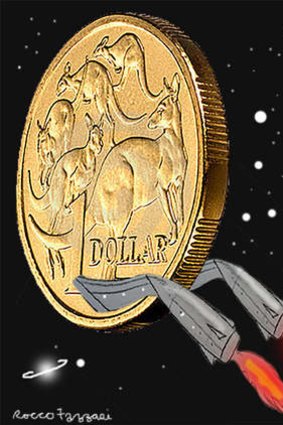It's obvious from the minutes of the Reserve Bank's April 1 rate-setting meeting that the central bank would be happier if the Australian dollar was lower, but there are no signs yet that it is considering actively talking the currency down, as it did late last year. Telling the markets they have their pricing wrong is always a fraught exercise, and it appears to see enough strength in the economy to avoid doing so.
The $A was at US91.2¢ on December 3 last year when the Reserve's board met, left the cash rate at 2.5 per cent and said that the currency was ''uncomfortably high'' and needed to fall ''to achieve balanced growth in the economy''.

Illustration: Rocco Fazzari.
The comments were repeated in the minutes of the meeting two weeks later, and they helped pull the dollar down. It was at US88.8¢ and 16 per cent below an April 2013 high of US105.7¢ on February 4 when the Reserve met again, and again left rates on hold. The currency's decline would help the economy re-balance, the Reserve said on the day, adding in the minutes two weeks later that a weaker currency was ''expansionary for economic activity''.
At the February meeting the Reserve also said that rates were set for ''a period of stability''. That took rate cuts off the table, and the $A had edged up slightly to US89.5¢ by March 4 when the board met and left the cash rate at 2.5 per cent again. In its announcement that day the Reserve again said a lower currency was positive for domestic growth, but added that the $A was still ''high by historical standards''.
By the time the Reserve board met two weeks ago on April 1, the $A was back up to US92.4¢ as economic data reinforced the market view that rate cuts were over, and the next move was up. The currency was higher than it was in early December when the Reserve said it needed to fall - but in its statement announcing no change to the cash rate, the central bank soft-pedalled. The $A was high by historical standards, it said again, but was still at a level that assisted the economy's rebalancing act, albeit by less than it would have if it had not rebounded.
The minutes of the Reserve's rate-setting meetings are drawn up soon after the meetings conclude. They reflect the view at that time, rather than the Reserve's view two weeks later, when they are published.
The latest minutes show, however, that while the Reserve is continuing to monitor the mismatch between the currency which is rising and Australia's terms of trade, which are weakening as commodity prices continue to soften, it doesn't feel the need to talk the $A down aggressively, by warning as it did in December that it is threatening a baton-change from the resources boom, for example, or, in extremis, by suggesting that it might be again considering rate cuts.
The minutes of the April 1 meeting certainly make it clear that the central bank would like the $A to fall. They report that the board was told that the currency had risen ''partly in response to domestic economic data'', was still historically high and at levels last seen in November last year, and had gone up despite falls in key commodity prices. The currency was still about 12 per cent below highs set a year earlier, the meeting heard, but would give the economy less assistance than expected before the bounce occurred.
''As jawboning goes, this is pretty lame, particularly as the divergence between AUD and commodity prices is widening,'' JPMorgan economist Stephen Walters said, adding that the Reserve's reticence was ''somewhat puzzling'' given importance of the $A to the economic outlook.
The latest minutes state that business conditions have generally improved, but business confidence fell in March, and the Reserve says businesses are waiting for demand to actually lift before committing to investment spending - spending that is a key component of the baton-pass to the non-resources economy that the Reserve is encouraging with low interest rates.
Walters says managers are consistently nominating the strength of the $A as a problem, and the currency has continued to rise since the central bank's April 1 meeting. It was changing hands at US94.26¢ ahead of the publication of the minutes on Tuesday, and eased to about US93.8¢ after it, still US2.6¢ higher than it was in December.
Why isn't the Reserve talking loudly about the $A being too high, as it did in December? Almost certainly because it will avoid jawboning the currency if it can, and is more confident that the economic transition it is seeking is occurring.
Reserve Bank governor Glenn Stevens has been upbeat in recent comments and speeches, and the latest minutes report that the board noted on April 1 that while falling mining investment and weak public demand were constraining growth and would for some time, there were ''early promising signs in other parts of the economy''.
They include the well-publicised pick-up in dwelling investment (there are no signs in the minutes that the Reserve thinks that a bubble is developing), export strength as the resources investment boom translates to higher production, and signs of strengthening consumer demand - a trigger if confirmed for higher business investment that would lock in the transition project.
mmaiden@fairfaxmedia.com.au